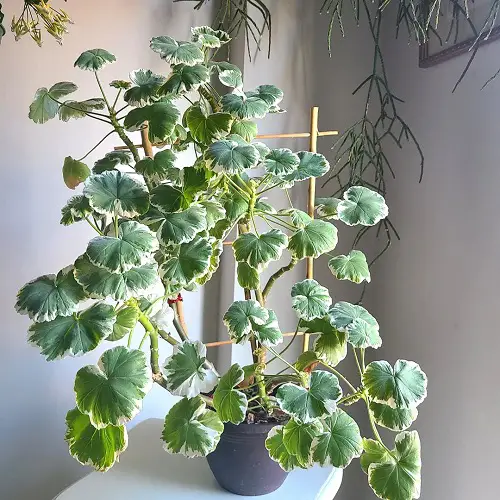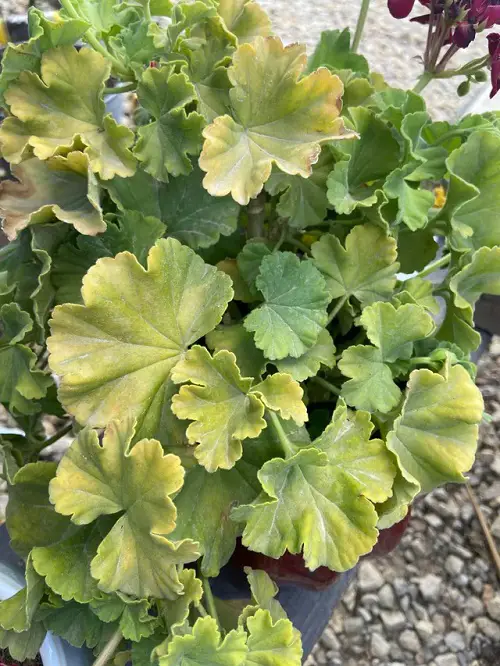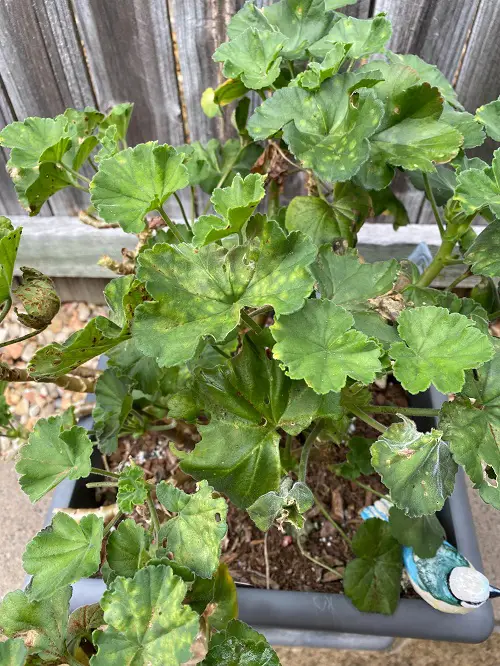Why Do Geranium Leaves Turn Yellow? Is there a specific reason behind it or several other factors? Let’s find out!

Yellow leaves in geraniums are quite common, so it is essential to know what is the correct reason behind this paleness, in order to bring them back to their lush green glory!
Why Do Geranium Leaves Turn Yellow?
1. Overwatering

If the leaves on your geranium plants start turning yellow, the main reason could be overwatering. These plants prefer dry conditions, and only need water once the top layer of soil begins to dry out.
Too much watering can make the leaves turn mushy and pale in no time.
2. Underwatering
On the flip side, if geraniums are underwatered, they start turning yellow as well. This happens because they can tolerate drought, but prolonged dryness can stress the plant.
If you think it has been a while since you last watered your plant and the soil is very dry, water it right away.
3. Lack of Light

Another reason why geraniums turn yellow is a lack of sunlight. They require at least 5-6 hours of direct or partial sunlight per day, and if you have placed them where this condition is not met, their leaves will start turning yellow.
4. Not Fertilizing Properly
Due to a lack of proper knowledge about fertilization, geraniums may be either over-fertilized, which burns the roots, or under-fertilized, causing the plant to struggle to get nutrients.
To find the right balance, feed the plant using a balanced liquid fertilizer, every 7-8 weeks, after diluting it to 1/4 of its strength. Also, refrain from feeding in colder months.
5. Cold Exposure
Geraniums thrive in warm climates, and when the weather becomes extremely cold, they enter the dormancy phase, where the leaves start turning yellow. Once the temperature rises again, the yellow leaves will fall off and new growth will begin.
Also, avoid exposing the plant to cold drafts and AC vents. The plants may die if they are exposed to temperatures below 35°F (2°C) for long.
6. Pests and Diseases

Unfortunately, various pests like aphids, spider mites, and fungal infections can also cause the leaves to turn yellow. Inspect the plant carefully to check for any pests or disease infestation to prevent this from happening.
7. Nutrient Deficiencies
Geraniums need the right mix of essential elements like nitrogen, magnesium, or iron to thrive and deficiency of either of these can make the old or new leaves pale.
Do make sure you follow the feeding routine discussed in 4th point.
8. Incorrect Growing Medium
Avoid using 100% garden soil for growing these plants, as it may be too compacted for its liking. It can also populate the roots, preventing them to absorb water and nutrients properly.
Add plenty of perlite, coco peat, and a handful of sand in the mix for the right growing environment for the plant.
9. Water Quality
Tap water is full of minerals that might not be good your geraniums. Overtime, these can build up in the soil, preventing the roots from absorbing nutrients, leading to pale foliage.
It is always good to keep the tap water overnight in a bucket, and use it the next morning. Better, go for RO, or lake water to avoid yellowing of leaves.
10. Root Bound Issues
If you haven’t re-potted the plant in 4-5 years, then this might also be the reason for yellow leaves. Tight circling of roots inside the pot restricts their growth, and the plant’s ability to absorb nutrients and water.
Always keep an eye on the topsoil and drainage hole. If you spot signs of roots there, re-pot the plant in 2 size bigger container than the old one, using a fresh growing medium.
11. Natural Aging
As the plant ages, the leaves start to turn yellow naturally. Apart from that, individual leaves have their own life cycle, and they eventually take a pale hue and fall when they end their life.
This is especially common in older leaves that are at the bottom of the plant. Prune on a regular basis to get rid of yellowing aged leaves to promote newer, greener growth.


